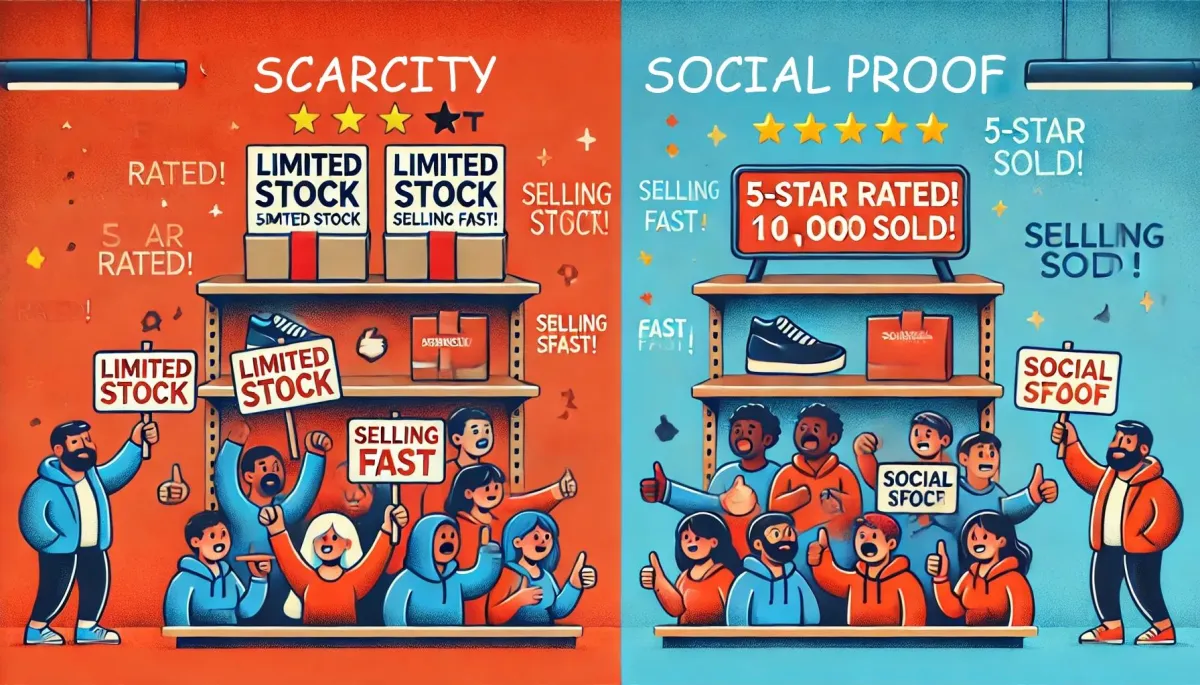Online Marketing Tips Blog
In this Daily blog, I'll try to answer the most burning questions for online marketing that I get in my consulting business. We help online business owners who are in affiliate marketing, coaching, eLearning and Online Events every single day. I'll share that info with you!

Scarcity or Social Proof? Which Drives Consumer Decisions Better?
Marketing often hinges on understanding human psychology. When it comes to persuasive techniques, two strategies reign supreme—scarcity and social proof. Both harness intrinsic human desires, but which one truly packs more punch in motivating consumers to make decisions? The answer isn't cut-and-dry because much depends on context, audience, and execution.
This blog unpacks the mechanics of scarcity and social proof, compares their effectiveness in different scenarios, and provides actionable insights to help marketing professionals strategically choose the right tool for the job.
What Is Scarcity in Marketing?
Scarcity plays on the fear of missing out (often referred to as FOMO). It taps into the principle that people assign greater value to things that are rare or limited in availability. The less there is of something, and the closer people feel to losing out, the more they’ll want it.
Core techniques that leverage scarcity:
• Limited Quantity: “Only 5 left in stock!”
• Time-bound Offers: “Sale ends in 24 hours.”
• Exclusive Access: “This pre-sale is for members only.”
These triggers create urgency in the consumer’s mind, compelling them to act before it's too late.
Real-Life Example of Scarcity
eCommerce giant Amazon exemplifies scarcity with phrases like, “Only 2 left in stock—order now!" This simple notification not only alerts potential buyers to limited availability but also creates a palpable sense of urgency that spurs immediate decisions.
Similarly, Black Friday sales are legendary for scarcity-based tactics, offering jaw-dropping discounts for a limited number of hours—or on just a few units of high-demand products.
Why Scarcity Works
Scarcity appeals to loss aversion, a principle derived from behavioral economics. The feeling of potentially losing access to something valuable motivates people far more than the possibility of gaining something equivalent.
What Is Social Proof in Marketing?
Social proof operates under a different psychological principle—herd behavior. This concept states that people tend to look to others’ actions to gauge what is desirable, valuable, or safe. It’s why seeing a line outside a restaurant automatically makes us think the food must be incredible.
Core techniques that leverage social proof:
• Customer Reviews/Testimonials: “Rated 4.9 stars by 10,000+ users.”
• Social Media Influence: “Trending on Instagram.”
• Case Studies: Showing success stories of existing customers.
• Celebrity Endorsements: Leveraging well-known figures to vouch for your product or service.
Real-Life Example of Social Proof
Think about Tripadvisor. Every hotel or restaurant decision you make on the platform is influenced by user reviews, ratings, and photos. Seeing thousands of 5-star reviews automatically builds trust and reinforces your decision to book a stay or visit.
Another iconic example is Apple's AirPods. When consumers saw them suddenly appearing everywhere—on influencers, in public places, and even characters in sitcoms—it signaled that AirPods were worth the investment. Their ubiquity turned into their biggest selling point.
Why Social Proof Works
Social proof validates decisions. It gives potential customers confidence in their choice, reducing the psychological risk and effort involved in making the “wrong” call.
Scarcity vs. Social Proof: Head-to-Head Comparison
Now that we know how each strategy works, let's compare them across key marketing scenarios.
1. Creating Urgency
Scarcity is the clear winner here. If your goal is to get customers to act now, scarcity drives urgency. Time-limited sales, inventory alerts, or early bird offers compel consumers to make quick decisions without overthinking.
Example:
• An email saying “Only 24 hours left to get 50% off” will likely outperform “10,000 customers already love this product” in terms of immediate conversions.
2. Building Trust
Social proof edges out scarcity when trust is the priority. Seeing endorsements from others shows that your product delivers value and aligns with consumer expectations. Reviews, success stories, and influencer shoutouts build credibility that drives decisions—especially important for higher-ticket items or long-term subscriptions.
Example:
• A B2B SaaS company showcasing testimonials from well-known clients will fare better with social proof than scarcity tactics like “Limited licenses available.”
3. Entering Competitive Markets
In a crowded market with similar products, social proof is essential for differentiation. Demonstrating popularity or widespread adoption makes your product stand out among competitors.
Example:
• Imagine launching a new skincare product in an already saturated market. A product labeled “Loved by 250,000 customers” will likely draw more attention than advertising limited stock.
4. Driving High-Value Purchases
For items that require careful consideration (think electronics, luxury goods, or specialized services), social proof is more effective. Shoppers tend to lean on user reviews, expert recommendations, and case studies to justify a premium purchase.
5. Capitalizing on Impulse Buying
Scarcity reigns supreme in scenarios where the consumer is ready to make a quick decision—think flash sales or fast-moving eCommerce. By adding the pressure of time or limited availability, marketers can drive impulsive purchases.
Example:
• Fashion retailers often combine scarcity-driven language (“Last chance to own this season’s must-have”) with visuals of an already-popular item to maximize impulse buys.
Combining Scarcity with Social Proof for Maximum Impact
Do scarcity and social proof have to be rivals? Not at all. When paired strategically, they can amplify each other's effectiveness.
Combine Social Proof and Scarcity Tactics:
• Countdown Timers with Social Proof:
"Join the 15,000 happy customers who already snagged this deal—only 12 hours left!"
• Testimonial + Exclusive Offer:
"See why Sarah L. said, ‘This is a game-changer in skincare.’ Order yours today—limited stock available!”
• User Metrics + Time Frame:
"150 people have purchased this in the last hour—don't miss out!"
This fusion not only increases urgency but also reduces hesitation, giving customers both a reason to hurry and the confidence to proceed.
When to Use Scarcity vs. Social Proof Strategically
Choose Scarcity When:
• Running limited-time promotions or clearance sales.
• Urging customers to act fast during seasonal events.
• Boosting email or push notification conversions.
Choose Social Proof When:
• Building brand equity and trust in the early phase of a campaign.
• Marketing higher-value or complex offerings that require validation.
• Entering a new market and need a point of credibility.
Both scarcity and social proof are powerful psychological triggers in marketing, but their effectiveness depends on context. Scarcity pushes for immediate action, while social proof fosters trust and reassurance. The key is knowing your audience’s mindset and your campaign goals.
Feeling stuck? Try combining the two strategies—use scarcity to drive urgency and social proof to reduce hesitation.
Whether you're running an eCommerce promotion or launching a product in a competitive industry, understanding these psychological tools is your best bet for effective decision-driving.
Want to take your campaigns to the next level? A/B test scarcity and social proof on your website or ads to identify which resonates better with your unique audience. With time and practice, you'll find the perfect balance between them to unlock maximum conversions.
Our flagship training can help you get started in High Ticket Affiliate Marketing, eLearning & Courses, Events and Masterminds, along with Coaching. These Core Four businesses allow digital marketers to earn online. We can get you started for just $5 with a 5 Day Challenge, and if you are not satisfied, we’ll give you BACK your money!
Listen to a Podcast review of this system as well https://youtu.be/9MLpYzPztDI
https://www.allaffiliatecash.com/lll-blog
Disclaimer: If you click on links we provide and make a purchase, we may receive compensation. There is never any guarantee of income in any of the links or programs we provide.
If you have specific questions you would like to see answered in this blog, please send them to me at [email protected]. I will try to address every question here.
If you follow the links in my blog, some of them will be affiliate links and I will be compensated if you purchase a course or product from these links. This is no way increases your price or changes my opinion on these courses. I only recommend things I use in my business.
For the absolute best training online for Affiliate Marketing, Coaching, Events & Masterminds and eLearning - Online Courses: Check out our Flagship Program Here.

Copyright © 2025 | All Affiliate Cash | All Rights Reserved
There may be affiliate links on these pages. When you follow them and purchase something, I may be paid a commission. This does not raise your cost of the item, and does not influence my opinion or review of the item in any way.
NOT FACEBOOK™: This site is not a part of the Facebook™ website or Facebook Inc. Additionally, This site is NOT endorsed by Facebook™ in any way. FACEBOOK™ is a trademark of FACEBOOK™, Inc.

